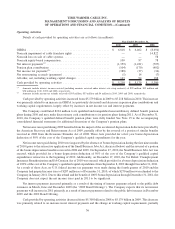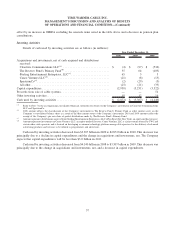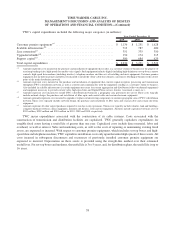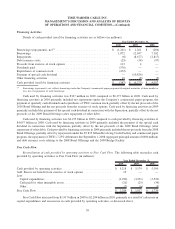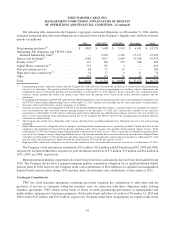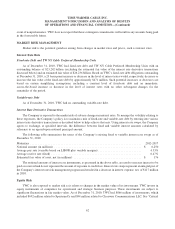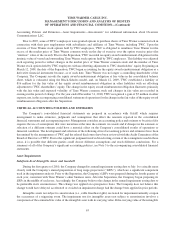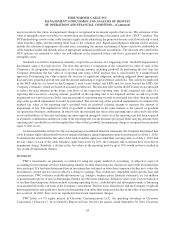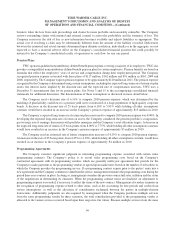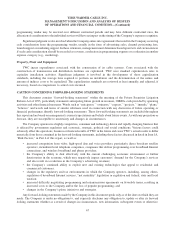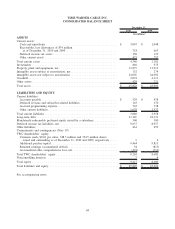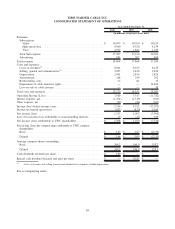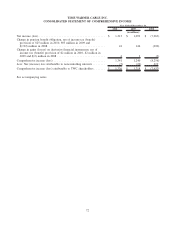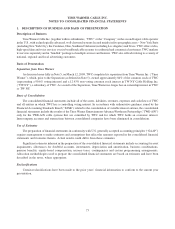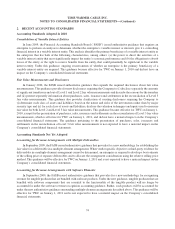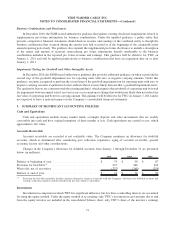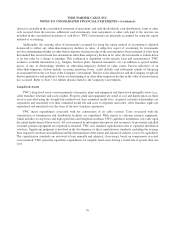Time Warner Cable 2010 Annual Report Download - page 78
Download and view the complete annual report
Please find page 78 of the 2010 Time Warner Cable annual report below. You can navigate through the pages in the report by either clicking on the pages listed below, or by using the keyword search tool below to find specific information within the annual report.business when the loss from such proceedings and claims becomes probable and reasonably estimable. The Company
reviews outstanding claims with internal and external counsel to assess the probability and the estimates of loss. The
Company reassesses the risk of loss as new information becomes available and adjusts liabilities as appropriate. The
actual cost of resolving a claim may be substantially different from the amount of the liability recorded. Differences
between the estimated and actual amounts determined upon ultimate resolution, individually or in the aggregate, are not
expected to have a material adverse effect on the Company’s consolidated financial position but could possibly be
material to the Company’s consolidated results of operations or cash flow for any one period.
Pension Plans
TWC sponsors qualified noncontributory defined benefit pension plans covering a majority of its employees. TWC also
provides a nonqualified noncontributory defined benefit pension plan for certain employees. Pension benefits are based on
formulas that reflect the employees’ years of service and compensation during their employment period. The Company
recognized pension expense associated with these plans of $117 million, $162 million and $91 million in 2010, 2009 and
2008, respectively. The Company expects pension expense to be approximately $120 million in 2011. The pension expense
recognized by the Company is determined using certain assumptions, including the expected long-term rate of return on plan
assets, the interest factor implied by the discount rate and the expected rate of compensation increases. TWC uses a
December 31 measurement date for its pension plans. See Notes 3 and 15 to the accompanying consolidated financial
statements for additional discussion. The determination of these assumptions is discussed in more detail below.
The Company used a discount rate of 6.16% to compute 2010 pension expense, which was determined by the
matching of plan liability cash flows to a pension yield curve constructed of a large population of high-quality corporate
bonds. A decrease in the discount rate of 25 basis points, from 6.16% to 5.91% while holding all other assumptions
constant, would have resulted in an increase in the Company’s pension expense of approximately $15 million in 2010.
The Company’s expected long-term rate of return on plan assets used to compute 2010 pension expense was 8.00%. In
developing the expected long-term rate of return on assets, the Company considered the pension portfolio’s composition,
past average rate of earnings, discussions with portfolio managers and the Company’s asset allocation targets. A decrease in
the expected long-term rate of return of 25 basis points, from 8.00% to 7.75%, while holding all other assumptions constant,
would have resulted in an increase in the Company’s pension expense of approximately $3 million in 2010.
The Company used an estimated rate of future compensation increases of 4.25% to compute 2010 pension expense.
An increase in the rate of 25 basis points, from 4.25% to 4.50%, while holding all other assumptions constant, would have
resulted in an increase in the Company’s pension expense of approximately $4 million in 2010.
Programming Agreements
The Company exercises significant judgment in estimating programming expense associated with certain video
programming contracts. The Company’s policy is to record video programming costs based on the Company’s
contractual agreements with its programming vendors, which are generally multi-year agreements that provide for the
Company to make payments to the programming vendors at agreed upon market rates based on the number of subscribers to
which the Company provides the programming service. If a programming contract expires prior to the parties’ entry into a
new agreement and the Company continues to distribute the service, management estimates the programming costs during the
period there is no contract in place. In doing so, management considers the previous contractual rates, inflation and the status
of the negotiations in determining its estimates. When the programming contract terms are finalized, an adjustment to
programming expense is recorded, if necessary, to reflect the terms of the new contract. Management also makes estimates in
the recognition of programming expense related to other items, such as the accounting for free periods and credits from
service interruptions, as well as the allocation of consideration exchanged between the parties in multiple-element
transactions. Additionally, judgments are also required by management when the Company purchases multiple services
from the same programming vendor. In these scenarios, the total consideration provided to the programming vendor is
allocated to the various services received based upon their respective fair values. Because multiple services from the same
66
TIME WARNER CABLE INC.
MANAGEMENT’S DISCUSSION AND ANALYSIS OF RESULTS
OF OPERATIONS AND FINANCIAL CONDITION—(Continued)


